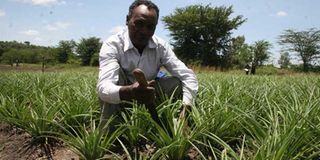Trust me, it pays big to grow flowers

Tuberose farmer Robert Mwangi on his farm in Gatuanyaga village, Thika. PHOTO | WILLIAM OERI
What you need to know:
- Flowers are considered a luxury in Kenya but easier access to incentives and a ready market abroad has drawn more small-scale farmers to the venture previously associated with large firms
- The industry earned Sh46 billion last year, up from Sh43 billion in 2012, according to Ms Jane Ngige, Kenya Flower Council chief executive officer
Robert Nduati’s day starts at 5am. After breakfast he tends to his chicken and goats and then does what he loves best— visit his flower farm, a few metres from his homestead as he waits for the workers to join him.
The 61-year-old ventured into floriculture in 2009 and says it is a lucrative undertaking. He chose the tuberose variety that can be harvested for three to five years.
Although he has expanded his flower farm in Gatuanyaga village in Thika to two acres, he started with an eighth of an acre which cost him less than Sh10,000 inclusive of labour and signed up with Wilmar Agro Ltd for deliveries.
The Thika-based firm bought the flowers each week, earning him an average of Sh10,000 per order. Seeing money was flowing in, he leased an acre at Sh10,000. The yields were encouraging so he increased the acreage to two. Wilmar Flowers exports flowers to the Netherlands and has contracted small holders across the country for supplies.
Wilmar sells seeds to the farmers at a subsidised price. A 70- kilo bag of tuberose seeds costs Sh3,000 and Wilmar gives one bag free for each purchased. An acre requires 12 bags.
Nduati now harvests up to 5,000 stems per week, with each selling at an average of Sh5. In a month during peak production, he earns up to Sh120,000. The money is paid weekly, guaranteeing him income and even security for a loan from financial institutions.
The steady income has seen him educate his two children at local universities and two others complete high school.
The land is located close to quarries in Thika East, where you would think nothing grows. His farm is separated from the Machakos County by Athi River but he waters his flowers from another source. A natural spring at the heart of the quarries has seen hundreds of farmers set up pipes drawing water into their dams. The spring is also used for drinking water and watering animals.
Nduati has also sunk a dam a few metres from the flower farm, which he uses for irrigation. He relies on casual labourers at Sh150 each daily during planting, weeding, pruning, top dressing and harvesting.
“When you empower your neighbours they support your venture, with no risk of theft,” says Nduati. And transport is guaranteed just like the market.
The flower firm collects flowers for storage in cold rooms and processing for export.
Flowers are considered a luxury in Kenya but easier access to incentives and a ready market abroad has drawn more small-scale farmers to the venture previously associated with large firms.
Nduati and other small-holders grow summer flowers for export to the Netherlands during the winter season. They are referred to as summer flowers because they flourish during summer in the Netherlands and during winter the demand for summer flowers from Kenya is high. The sweet scent of tuberoses has pushed their demand at the Holland auction.
To harvest stems every week, Nduati plants flowers in phases so that they mature at different times. The flowers mature in six months.
“I can pick flowers for two consecutive weeks, twice on each plot,” said Nduati.
When is the best time to plant?
“Between March and April because demand peaks between September and December,” says Joseph Kanyi, Wilmar’s production manager.
Apart from the availability of land, capital and seedlings, Nduati says drive and patience are key for success in flower farming.
“Some had everything but lack of perseverance saw them give up, they now admire my strong will,” he says.
To him the major challenge is not pests and disease or even fertiliser or labour, but hippos from the Athi River which trample on his flowers.
How did he avoid the curse of middlemen? Simple, Nduati says. Small-holders in the area formed a group to negotiate with exporters and regulators. They do not deal with brokers.
“It is hard to get a market as a single farmer, we have formed a group of 30 of us,” says Nduati.
GRADING AND RISING DEMAND
He says more exporters are turning to smallholders partly because of competition and rising demand that cannot be met by big firms alone.
The flowers are graded according to the length with the first grade of 80 centimetres selling at Sh6.50 a stem, while a 70 centimetre one goes for Sh5.
Mr Kanyi says the tuberose does well in low temperature areas, but farmers are slow in embracing it.
The industry earned Sh46 billion last year, up from Sh43 billion in 2012, according to Ms Jane Ngige, Kenya Flower Council chief executive officer. Output, increased to 125,000 tonnes, from 120,000 tonnes the previous year, thanks to favourable weather.




